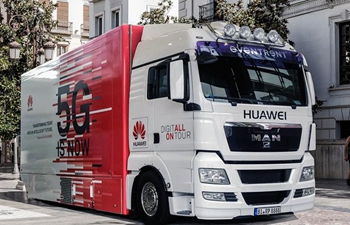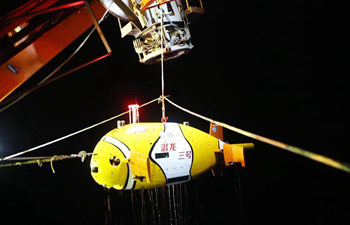
Photo taken on April 23, 2018 shows Jan Mrosik, chief executive officer of Siemens digital factory, during Hanover Fair 2018 in Hanover, Germany. Digitalization is disruptive for industries by generating both huge opportunities and risks to companies, Jan Mrosik told Xinhua in an interview during the Hanover Fair starting on Monday. (Xinhua/Shan Yuqi)
HANOVER, April 24 (Xinhua) -- Digitalization is disruptive for industries by generating both huge opportunities and risks to companies, Jan Mrosik, chief executive officer of Siemens digital factory, told Xinhua in an interview during the Hanover Fair starting on Monday.
"Digitalization is on the one side a huge opportunity because a lot of money will be gained by digitalizing, " Mrosik said, "but on the other side it's a huge risk for companies that do not embrace it. "
He cited the data from consulting company Accenture, saying that half of the Fortune 500 companies have disappeared out of the market since 2000 because they were not embracing digitalization sufficiently.
Under the motto of "Digital Enterprise-Implement now!", Siemens is presenting its continuously enhanced Digital Enterprise portfolio for Industry 4.0 at this year's Hanover Fair.
Mrosik said, by digitalizing companies should achieve shorter time to market, greater flexibility, better quality and higher efficiency.
Besides, new business models can be developed from it. Among all the digital enterprise solutions Siemens is presenting the new version of the open, cloud-based internet of things(IoT) operating system MindSphere belongs to the key ones.
According to Siemens, connecting to MindSphere is one of the foundational aspects of new, data-driven business models for customers.
"For example, instead of buying a machine, you can lease one, " Mrosik said.
He continued that in a digitalizing world, virtual and real world are "two sides of the same coin". With the digital twin, a virtual representation of a physical object or system across its lifecycle, industrial companies can optimize and digitalize the whole value chain.
"Digitalization is a journey that never stops," Mrosik said,"we should continually update what we are doing. "
Siemens digital factory in Amberg is probably one of the shiny examples of Industry 4.0. "That's why our customers keep visiting there to see how we implement it. "
Mrosik said that continuous digitalization and implementation of MindSphere enables the smart factory in Amberg to produce 13 times more with the same number of 1300 employees as in 1989. And it can manufacture 1200 different products with the same lines. The efficiency and quality have also been improved substantially.
"It showcases what you can achieve or optimize with digitalization." Mrosik said. "And we have an exact copy of this digital factory in Chengdu, so our Chinese customers don't need to travel so far to see it in Amberg."
For the reason to ground a same digital factory in China, Mrosik explained, "Since China is such an important market for Siemens, we decided to have a lot of added value close to our customers in China."
He said companies need to produce where markets are, "we need to be close to our customers".
For now, production in Siemens Chengdu digital factory accounts for 15 percent of the company's whole electronics outputs. Besides manufacturing, Mrosik said that Siemens also invested more in R&D in China.















